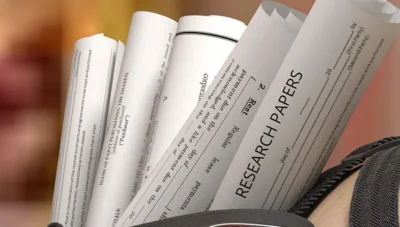Imagine starting your paper with a question that beckons the reader to ponder the unexplored realms of your research. Picture painting a vivid scenario, drawing readers into your study as if they were witnessing it unfold firsthand.
Alternatively, consider startling your audience with a compelling statistic that highlights the urgency or relevance of your work. A cleverly chosen quote, resonating with the essence of your research, can also serve as a powerful hook, infusing your paper with a touch of literary finesse.
So, in this article, we unravel the intricacies of employing hooks for research papers, examining their significance in establishing a connection between the researcher’s work and the reader’s curiosity.
What is hooks for research papers?

In the context of research papers, “hooks” refer to engaging elements or strategies used in the introduction to capture the reader’s attention and encourage them to continue reading.
The purpose of a hook is to make the reader interested in the topic and motivate them to explore the content further. A well-crafted hook can set the tone for the entire research paper and create a positive impression.
10 Types of hooks for research papers
Hooks are introductory sentences or paragraphs in research papers designed to grab the reader’s attention and draw them into the content of the paper. There are various types of hooks that writers can use, depending on the tone, topic, and purpose of the research paper.
Here are some common types of hooks:
- Anecdotal Hook:
-
- Start with a short, interesting story or anecdote related to your topic. This personalizes the subject matter and can engage the reader emotionally.
- Quotation Hook:
-
- Begin with a relevant quote from a well-known person or a credible source. This can add authority to your paper and provide a thought-provoking start.
- Statistical Hook:
-
- Introduce your topic with a surprising or compelling statistic. Numbers can capture attention and emphasize the significance of your research.
- Question Hook:
-
- Pose a thought-provoking question that relates to your topic. This encourages the reader to think about the subject matter and may prompt them to continue reading for an answer.
- Contrast or Comparison Hook:
-
- Highlight a stark contrast or comparison related to your topic. This can create intrigue and set the stage for the main points you will discuss.
- Definition Hook:
-
- Start by defining a key term or concept relevant to your research. This can help establish clarity and understanding from the beginning.
- Historical Hook:
-
- Provide a brief historical context or background related to your topic. This can help the reader understand the significance of the research within a broader context.
- Current Event Hook:
-
- Connect your research to a recent event or news story. This makes your paper timely and relevant.
- Scenario Hook:
-
- Present a hypothetical scenario that illustrates the importance of your research. This can help the reader envision the practical implications of your work.
- Bold Statement or Assertion Hook:
-
- Make a bold statement or assertion that challenges common beliefs or provokes thought. Ensure that the statement is relevant to your research.
Remember that the effectiveness of a hook depends on its relevance to your topic and its ability to capture the reader’s interest. It’s essential to seamlessly transition from the hook to the thesis statement, which outlines the purpose and main points of your research paper.
How do hooks impact research paper readership?

Hooks play a crucial role in capturing the attention [Attention grabber] of research paper readers. A hook is essentially the opening sentence or paragraph that aims to grab the reader’s interest and encourage them to continue reading. Think of it as the “bait” that lures in your audience.
If your research paper has a compelling hook, it can positively impact readership in several ways:
- Engagement: A strong hook keeps readers interested and engaged from the very beginning. It sparks curiosity and encourages them to delve deeper into your paper.
- Relevance: Hooks can establish the relevance of your research to the reader’s interests or real-world issues. This connection makes them more likely to see the importance of your work.
- Memorability: A memorable hook can stick in the reader’s mind, making your paper stand out among others. This can be especially important in a field with a lot of competing research.
- Motivation to Continue: Readers are more likely to continue reading if they find the opening of your paper interesting or thought-provoking. This initial positive experience can set the tone for the entire paper.
How do emotional hooks aid scientific communication?
Emotional hooks play a crucial role in scientific communication by making the content more engaging and relatable to a broader audience.
While scientific communication traditionally focuses on presenting facts, data, and research findings, incorporating emotional elements can enhance the overall impact and accessibility of the information.
Here are several ways emotional hooks aid scientific communication:
- Increased Engagement:
-
- Emotional hooks capture the audience’s attention and maintain their interest throughout the communication.
- People are more likely to remember and engage with information that evokes an emotional response.
- Enhanced Understanding:
-
- Emotional elements can help convey complex scientific concepts in a more digestible manner by providing real-world contexts and relatable scenarios.
- Analogies or metaphors that evoke emotions make it easier for the audience to grasp abstract or technical concepts.
- Improved Retention:
-
- Emotionally charged content is more memorable, leading to better retention of scientific information.
- Emotional connections create a lasting impact, helping the audience remember key messages and findings.
- Connection with the Audience:
-
- Emotions foster a sense of connection between the communicator and the audience.
- Sharing personal stories or anecdotes related to the scientific topic can create a more human connection, making the information more accessible and relatable.
- Motivation for Action:
-
- Emotional hooks can inspire action by appealing to the audience’s emotions, values, or sense of responsibility.
- When people feel a personal connection to scientific information, they may be more motivated to support relevant causes, adopt certain behaviors, or advocate for change.
- Overcoming Apathy:
-
- Many scientific topics face challenges of public apathy or disinterest. Emotional hooks help overcome this by making the information personally relevant and compelling.
- Emotional engagement can turn passive listeners into active participants in the scientific discourse.
- Storytelling as a Vehicle:
-
- Crafting narratives around scientific findings or discoveries can serve as a powerful emotional hook.
- Stories with relatable characters, challenges, and resolutions can captivate audiences and convey scientific information in a compelling way.
- Building Trust:
-
- Emotional communication can contribute to building trust between scientists, researchers, and the public.
- When scientists share their passion, dedication, and personal investment in their work, it humanizes the scientific process and fosters trust in the information being presented.
Incorporating emotional hooks does not compromise the scientific integrity of the communication; rather, it enriches the communication strategy and makes scientific information more accessible and impactful to a wider audience.

Is there a link between hook clarity and content comprehension?
The clarity of a hook, often the opening or introductory part of any content, significantly impacts content comprehension. A hook serves as the initial point of engagement, enticing the reader or audience to delve deeper into the material.
When a hook is clear and attention-grabbing, it sets the tone for what follows and can enhance comprehension by:
- Capturing Attention: A clear hook immediately grabs the audience’s attention, making them more inclined to focus on the content that follows.
- Providing Context: It offers a framework or context for the information to come, helping the audience anticipate what they’ll learn and guiding their comprehension.
- Aiding Understanding: A well-crafted hook often hints at the main theme or idea of the content, preparing the audience mentally and priming them for better understanding.
- Creating Interest: Clarity in a hook makes the content more intriguing, motivating the audience to continue reading or listening, which in turn aids comprehension as they remain engaged.
However, a lack of clarity in the hook can have adverse effects. If it’s confusing, misleading, or ambiguous, it may deter the audience from understanding the content that follows. Unclear hooks might confuse the reader, making them struggle to grasp the purpose or main point of the content.
So, there is indeed a strong connection between the clarity of a hook and the comprehension of the content it introduces. A clear and effective hook sets the stage for improved comprehension and engagement with the material.
Conclusion
On this page, you will learn more about the hooks for research papers. A clear and compelling hook serves as the gateway to the entire document, capturing the reader’s attention and providing a roadmap for the research. It establishes the context, generates interest, and lays the foundation for effective communication.
A strong hook not only entices the reader to delve deeper into the paper but also enhances overall comprehension by guiding them through the key themes and objectives. In essence, the hook acts as a crucial tool for engaging and guiding the audience through the complexities of the research, ensuring a more meaningful and impactful reading experience.

